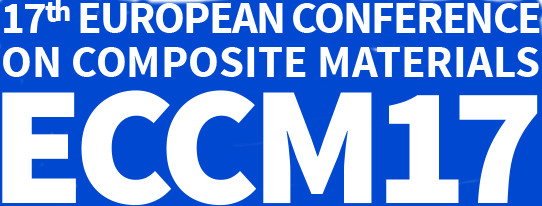

App-Einstellungen:
HOMOGENIZATION OF TEMPERATURE-DEPENDENT SHORT FIBER REINFORCED POLYPROPYLEN AND EXPERIMENTAL INVESTIGATIONS OF LONG FIBER REINFORCED VINYLESTER
Loredana Kehrer (Karlsruhe Institute of Technology) Pascal Pinter (Karlsruhe Institute of Technology) Thomas Böhlke (Karlsruhe Institute of Technology)
Using µCT data, effective material properties are calculated by the self-consistent, the interaction direct derivative and the Hashin-Shtrikman two-step method. Material properties of short and long fiber reinforced polymers are determined by DMA.
LOCAL REINFORCEMENT INFLUENCE ON CORRUGATED LAMINATES STRUCTURAL STIFFNESS RESPONSE FOR FLEXIBLE SKINS
Claudia Thurnherr (ETH Zürich) Carlo M. Franceschi (ETH Zürich) Francesco M. Filotto (ETH Zürich) Gerald Kress (ETH Zürich) Paolo Ermanni (ETH Zürich)
The present study investigates the influence of local reinforcements for corrugated laminates on the anisotropic stiffness response in order to optimize the bending to axial stiffness ratio.
MICRO-SCALE FINITE ELEMENT STUDY OF THE DAMPING IN UNIDIRECTIONAL FIBER REINFORCED COMPOSITES
Ali Rezaei (Ghent University) David Garoz Gomez (Ghent University) Jana Faes (Ghent University) Francisco A. Gilabert (Ghent University) Wim Desmet (KU Leuven) Wim Van Paepegem (Ghent University)
This article employs the strain energy finite element method to study the anisotropic damping of unidirectional fiber reinforced composites in micro-scale.
EFFICIENT MODELLING AND ACCURATE CERTIFICATION OF CURVED AEROSPACE LAMINATES
Timothy Fletcher (University of Bath) Anne K. Reinarz (University of Bath) Timothy Dodwell (University of Exeter) Richard Butler (University of Bath) Robert Scheichl (University of Bath) Richard Newley (University of Bath)
FEA of 4-Point Bend and L-Pull tests confirm that, away from the edges, the L-Pull generates plane strain conditions, indicative of a wide part. Resin treatment supresses edge effects. FEA solver DUNE has potential for highly paralellized efficiency.
MULTI-SCALE MATERIAL MODEL FOR 3D COMPOSITE USING MICRO CT IMAGES GEOMETRY RECONSTRUCTION
Yang Liu (Ecole des Mines de Douai) Ilya Straumit (KU Leuven) Dmytro Vasiukov (Ecole des Mines de Douai) Stepan Lomov (KU Leuven) Stéphane Panier (Ecole des Mines de Douai)
3D real model was reconstructed from micro CT images by taking advantage of the software VoxTex. Based upon such model both predicted linear and nonlinear mechanical behaviors showed good agreement with the experiments.
MULTISCALE MODELLING AND SIMULATION OF FAILURE IN METAL-COMPOSITE INTERFACES
Franz Hirsch (Technical University of Dresden) M. Kästner (Technical University of Dresden)
In this contribution the inelastic behavior of bi-material interfaces is considered within a numerical homogenization approach. Studies show the influence of the elastic properties and the surface roughness on the overall interface characteristics.
MULTISCALE SIMULATION OF DAMAGE AND HEALING OF COMPOSITE STRUCTURES
Lucas Brely (Universita di Torino) Federico Bosia (University of Torino) Nicola Pugno (University of Trento)
We developed a numerical model to simulate the mechanisms involved in damage progression and energy dissipation in complex structures, considering heterogeneities, hierarchical structure and structural modifications of the material.
NEW PHENOMENOLOGICAL FAILURE MODEL FOR COMPOSITE MATERIALS FROM A HOMOGENIZED MICROMECHANICS APPROACH
Shari King (University of Waterloo) Trevor Sabiston (University of Waterloo) Mohsen Mohammadi (University of New Brunswick) Kaan Inal (University of Waterloo)
This work aims to accurately predict the response and failure of a unidirectional long-fibre composite materials using a physically based constitutive law.
SIMULATION ON THERMO-PHYSICAL PROPERTIES OF FINE WEAVE PIERCED C/C COMPOSITE
Heng Liang (Nanjing University of Aeronautics and Astronautics) Mingbo Tong (Nanjing University of Aeronautics and Astronautics) Yuqing Wang (Nanjing University of Aeronautics and Astronautics)
Based on the meso and micro structures of fine woven pierced c/c composite, finite element models of single yarn and c/c composite are established respectively. By using the periodic boundary condition, the thermo-physical properties of composite are calculated.
VIRTUAL MATERIAL CHARACTERIZATION PROCESS FOR COMPOSITE MATERIALS: AN INDUSTRIAL SOLUTION
Laszlo Farkas (Siemens Industry Software NV) Kristof Vanclooster (Siemens Industry Software NV) Hunor Erdelyi (Siemens Industry Software NV) Ruben Sevenois (Ghent University) Stepan Lomov (KU Leuven) Tadashi Naito (HONDA R&D) Yuta Urushiyama (HONDA R&D) Wim Van Paepegem (Ghent University)
This contribution demonstrates the different steps of a Virtual Material Characterization (VMC) process applied for the prediction of elastic properties of a real meso-scale composite geometry.
